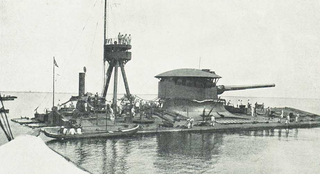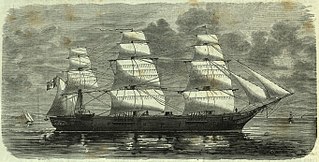
The Italian Navy is the navy of the Italian Republic. It is one of the four branches of Italian Armed Forces and was formed in 1946 from what remained of the Regia Marina after World War II. As of August 2014, the Italian Navy had a strength of 30,923 active personnel, with approximately 184 vessels in service, including minor auxiliary vessels. It is considered a multiregional and a blue-water navy.

SS Cristoforo Colombo was an Italian ocean liner built in the 1950s, sister ship of the SS Andrea Doria.

SMS Friedrich der Grosse was an ironclad turret ship built for the German Kaiserliche Marine. She was the second of three Preussen-class ironclads, in addition to her two sister-ships Preussen and Grosser Kurfürst. Named for Frederick the Great, she was laid down at the Imperial Dockyard in Kiel in 1871 and completed in 1877. Her main battery of four 26 cm (10 in) guns was mounted pair of twin gun turrets amidships.
Colombo is the largest city and commercial capital of Sri Lanka.

SS Leonardo da Vinci was an ocean liner built in 1960 by Ansaldo Shipyards, Italy for the Italian Line as a replacement for their SS Andrea Doria that had been lost in 1956. She was initially used in transatlantic service alongside SS Cristoforo Colombo, and primarily for cruising after the delivery of the new SS Michelangelo and SS Raffaello in 1965. In 1976 the Leonardo da Vinci became the last Italian Line passenger liner to be used in service across the North Atlantic. Between 1977 and 1978 she was used as a cruise ship by Italia Crociere, but was laid up from 1978 onwards until 1982 when she was scrapped.

The Francesco Caracciolo-class battleships were a group of four battleships designed for the Regia Marina in 1913 and ordered in 1914. The first ship of the class, Francesco Caracciolo, was laid down in late 1914; the other three ships, Cristoforo Colombo, Marcantonio Colonna, and Francesco Morosini followed in 1915. Armed with a main battery of eight 381 mm (15 in) guns and possessing a top speed of 28 knots, the four ships were intended to be the equivalent of the fast battleships like the British Queen Elizabeth class.

The Calypso class comprised two steam corvettes of the Royal Navy. Built for distant cruising in the heyday of the British Empire, they served with the fleet until the early twentieth century, when they became training ships. Remnants of both survive, after a fashion; HMS Calliope in the name of the naval reserve unit the ship once served, and HMS Calypso both in the name of a civilian charity and the more corporeal form of the hull, now awash in a cove off Newfoundland.

Faà di Bruno was an Italian monitor built during World War I. Completed in 1917, the ship played a small role in the 11th Battle of the Isonzo later that year. She was decommissioned in 1924, but returned to service as the floating battery GM 194 at the beginning of World War II and was towed to Genoa and where she spent the rest of the war. The ship had her guns disabled when the Royal Navy bombarded Genoa in 1941. GM 194 was captured by the Germans after the Italian Armistice in 1943 and was turned over to the puppet Repubblica Sociale Italiana that they installed afterward. She was scuttled at the end of the war and subsequently scrapped.

Cristoforo Colombo was a steel-hulled corvette built in the early 1890s for the Italian Regia Marina. The ship was built as a replacement for an earlier vessel of the same name, based on a nearly identical design. The new ship was intended to serve in Italy's colonial empire in eastern Africa, and was designed to be able to operate at long range, far from home ports, for an extended period of time.

An unprotected cruiser was a type of naval warship in use during the late Victorian or pre-dreadnought era. The name was meant to distinguish these ships from “protected cruisers” which had become accepted in the 1880s. A protected cruiser did not have side armor on its hull like a battleship or “armored cruiser” but had only a curved armored deck built inside the ship – like an internal turtle shell – which prevented enemy fire penetrating through the ship down into the most critical areas such as machinery, boilers, and ammunition storage. An unprotected cruiser lacked even this level of internal protection. The definitions had some gray areas because individual ships could be built with a protective deck that did not cover more than a small area of the ship, or was so thin as to be of little value. An unprotected cruiser was generally cheaper and less effective than a protected cruiser, while a protected cruiser was generally cheaper and less effective than an armored cruiser.

Vettor Pisani was a screw corvette of the Italian Regia Marina built in the late 1860s and early 1870s. The ship left Italy in 1882 for a three-year voyage round the world.
Cristoforo Colombo (1451–1506) was an Italian explorer better known as "Christopher Columbus".

Palinuro is a three-masted, iron-hulled barquentine, active as sail training vessel for the Italian Navy.

Coatit was a torpedo cruiser of the Italian Regia Marina built in the late 1890s. She was the second and final member of the Agordat class. The ship, which was armed with twelve 76 mm (3 in) guns and two 450 mm (17.7 in) torpedo tubes, was too slow and short-ranged to be able to scout effectively for the fleet, so her career was limited. She saw action during the Italo-Turkish War in 1911–12, where she provided gunfire support to Italian troops in North Africa. She also caused a minor diplomatic incident from an attack on retreating Ottoman soldiers in Anatolia. Coatit was part of an international fleet sent to Constantinople when the city appeared to be at risk of falling to the Bulgarian Army during the First Balkan War. In 1919, she was converted into a minelayer and was sold for scrap in 1920.
Francesco Caracciolo or Ammiraglio Caracciolo or simply Caracciolo was the name of at least two ships of the Italian Navy named in honour of Francesco Caracciolo and may refer to:

Cristoforo Colombo was a screw corvette of the Italian Regia Marina built in the 1870s.

Flavio Gioia was a screw corvette of the Italian Regia Marina built in the late 1870s and early 1880s.

Caracciolo was a screw corvette of the Italian Regia Marina built in the 1860s. She was the first vessel of that type built after the unification of Italy, though the Italian fleet inherited several screw corvettes from the navies of Naples, Tuscany, and Sardinia. The ship was armed with a main battery of six 160 mm (6.3 in) guns. Originally built with both steam and sail propulsion, Caracciolo later had her engine removed for use as a training ship.
This page is based on this
Wikipedia article Text is available under the
CC BY-SA 4.0 license; additional terms may apply.
Images, videos and audio are available under their respective licenses.














